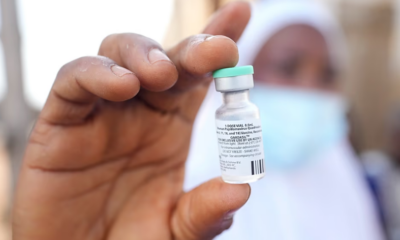Health
Experts Warn Poorly Designed Tech Could Add to Doctors’ Workload, Not Ease It

Artificial intelligence (AI) could transform healthcare by easing administrative burdens, but experts warn that if implemented poorly, it risks making doctors’ workloads even heavier. The issue took centre stage at the World Health Summit in Berlin this week, where global health leaders debated how to strengthen a strained medical workforce.
The three-day summit gathered scientists, policymakers, and healthcare professionals to explore innovative solutions for overworked medical staff. With emergency medicine and primary care doctors across the world facing long hours, mounting paperwork, and mental fatigue, many participants said that digitalisation must focus on helping doctors, not hindering them.
Axel Pries, director of the World Health Summit, criticised the growing bureaucratic pressure on hospital staff, saying many doctors feel they have drifted away from the essence of medicine. “It’s true that many doctors, but also others, feel they are no longer doing what they were trained for — to meaningfully interact with patients — but are instead feeding a huge bureaucratic juggernaut,” Pries said.
He pointed to digital systems as a cautionary tale, noting that early attempts to modernise hospitals often had the opposite effect. “One of the main reasons doctors in America have suffered from burnout over the last 20 years was the introduction of digital systems,” he said. “But that’s because those systems weren’t intelligent — they were cumbersome and demanded even more clicks, forms, and screens.”
While Pries believes that AI can play a crucial role in solving these problems, he emphasised that its effectiveness depends on data quality and context. “If AI is trained only on data from one population, such as in America, it may not work properly for people in Africa or China,” he said, highlighting the risks of bias and misrepresentation in medical algorithms.
He also raised the issue of data privacy, calling public attitudes “contradictory.” “People today willingly share personal details on social media, but are wary when hospitals or research institutions ask for data,” he said. “There’s a big difference between giving my information to Amazon or Google and sharing it with a hospital like Charité.”
A 2020 survey by the Marburger Bund medical union found that German hospital doctors spend an average of three hours per day on administrative tasks — time that could otherwise be spent with patients. About 60 percent of doctors reported that bureaucracy significantly impacts their work.
Experts at the summit agreed that for digital tools and AI to make a real difference, they must be practical, transparent, and built around doctors’ needs. Without thoughtful implementation and stronger policy support, they warned, digitalisation could deepen burnout rather than relieve it.
Health
Global Study Finds Sleep May Play Greater Role Than Exercise in Overall Health

A major international study has found that only a small share of people manage to meet recommended levels of both sleep and daily physical activity, raising new questions about long-standing health guidelines and how people can realistically follow them.
The research, published in the journal Communications Medicine, analysed data from wearable sleep and activity trackers from more than 70,000 people across multiple regions over a period of three and a half years. The findings show that only about 13 per cent consistently achieved the commonly promoted targets of seven to nine hours of sleep each night and at least 8,000 steps per day.
Lead author Josh Fitton, a sleep researcher at Flinders University in Australia, said the results highlight the gap between public health recommendations and everyday routines. “Only a tiny fraction of people can achieve both recommended sleep and activity levels every day, so we really need to think about how these guidelines work together and what we can do to support people to meet them in ways that fit real life,” he said.
The study revealed that people often manage to either get sufficient rest or maintain an active routine, but struggle to sustain both. Nearly 17 per cent of participants averaged fewer than seven hours of sleep and fewer than 5,000 steps daily, placing them in what researchers described as a “sedentary” group. This combination has been linked in past studies to a higher likelihood of chronic illness, weight gain and mental health issues.
Researchers noted that the data has limitations, as tracking devices tend to be more commonly used in higher-income countries, potentially skewing the global representation. Even so, the analysis uncovered a consistent pattern across participants: those who slept between six and seven hours a night recorded the highest number of steps the next day.
Senior author Danny Eckert, also from Flinders University, said the findings suggest that sleep may play a stronger role than many realise in shaping daily energy and activity levels. “Prioritising sleep could be the most effective way to boost your energy, motivation, and capacity for movement,” he said.
He added that small adjustments can help people build healthier routines. This includes reducing screen exposure before bed, maintaining regular sleep schedules and creating calming nighttime environments to support better rest.
The study’s authors say the results point to a need for clearer and more practical guidance, especially for people who struggle to balance work, family responsibilities and personal health goals. They say that for many, improving sleep habits may be the most realistic first step toward leading more active and healthier lives.
Health
European Workplaces Face Growing Mental Health Crisis Despite Record Corporate Spending

European companies are pouring unprecedented sums into employee well-being, yet mental health indicators across the workforce continue to deteriorate, raising concerns among researchers, unions and public health agencies.
A continent-wide survey released this year by the European Agency for Safety and Health at Work found that nearly half of workers across 30 countries report overwhelming workloads, while a third feel undervalued in their roles. Another 16 percent say they have faced violence or verbal harassment at work, underscoring the strain many employees experience on a daily basis.
The rise in workplace stress comes even as businesses expand support programmes at a rapid pace. In 2023, companies across Europe spent an estimated $19.6 billion (€16.9 billion) on wellness offerings, which now reach nearly a third of European employees. These initiatives include mindfulness sessions, coaching and stress management training. But researchers say such efforts often miss the root causes of worker distress.
A study by Australian researchers earlier this year labelled the situation a “prevailing paradox,” noting that increasing investment has not translated into improved mental health outcomes. Experts argue that many programmes remain surface-level and fail to target the structural pressures embedded in modern employment.
“After the pandemic, we saw a surge in people experiencing mental health issues linked to work, particularly burnout,” said Sonia Nawrocka of the European Trade Union Institute. She noted that psychosocial risks — such as excessive working hours, job insecurity, limited recognition and workplace bullying — continue to rise despite the attention on wellness.
Manal Azzi, a senior occupational safety and health specialist at the International Labour Organization, stressed that meaningful progress requires companies to rethink how they operate. Recruitment, promotion, performance assessments, management styles and communication practices all influence employee well-being, she said.
Research from TELUS Health suggests that managers who successfully support their teams share several traits, including genuine concern for staff, inclusive leadership, clear decision-making and a focus on purpose rather than just tasks.
Some employers are beginning to adopt wider reforms. Trials of the four-day work week in countries such as the United Kingdom, Ireland, Iceland and Germany have shown early promise in reducing burnout and improving workers’ overall health.
Even so, Azzi said many companies remain hesitant to address deeper organisational issues, often due to perceived cost or uncertainty about how to begin. This is where policy may play a greater role, according to Nawrocka. Sweden has rules to tackle workplace intimidation and unhealthy workloads, while France, Belgium and Portugal enforce right-to-disconnect laws outside working hours.
The economic impact is significant. An ETUI study found that stress-related depression and heart conditions cost the European Union more than €100 billion annually, with employers carrying most of the financial burden.
“When anxiety or depression becomes severe, it can be too late,” Azzi warned. “People leave their jobs, and that’s why prevention is essential.”
Health
New Study Warns Tattoo Ink May Influence Immune Response and Disease Resistance

A major scientific study has raised fresh concerns about the impact of tattoo inks on the body’s immune system, suggesting that the pigments used to create tattoo designs may interfere with how the body responds to disease and vaccination.
Researchers at the Institute for Research in Biomedicine at the Università della Svizzera italiana (USI) examined the toxicity of pigments used in the three most common tattoo colours: black, red and green. The study, published in the journal PNAS, is being described by the team as the most extensive investigation yet into how tattoo inks interact with immune cells.
The scientists found that pigment does not remain confined to the skin. Instead, particles travel through the body and collect in immune tissues, where they can persist for years. Once inside these tissues, the ink triggers cell damage. Macrophages — immune cells responsible for clearing foreign substances — are unable to break down the pigment, leading to swelling and prolonged strain on the immune system.
Pigments used in red and black tattoos caused the strongest reactions in laboratory tests.
When the researchers examined tattooed mice, they recorded rapid movement of pigment to the lymph nodes, where it continued to accumulate for at least two months. The altered immune activity appeared to affect how the animals responded to vaccines. In tests, the mice showed a weaker response to COVID-19 vaccines after tattooing, although the same pigments appeared to strengthen the response to a UV-inactivated flu vaccine.
Scientists stressed that more work is needed to confirm these findings in humans and across a wider range of vaccines. The International Agency for Research on Cancer (IARC) is conducting separate research into possible long-term risks, including links between tattoo pigments, the immune system, and cancers such as lymphomas.
Researchers note that many pigment particles are extremely small, allowing them to circulate beyond the dermis, the layer of skin where tattoos are placed. This raises the possibility that exposure is not limited to the area of the tattoo.
Tattooing has become increasingly common, especially in Europe and the United States, where up to 40 percent of adults under 40 have at least one tattoo. IARC has said that the growth of the tattoo industry has turned pigment safety into a rising public health concern.
Tattoo ink can contain up to 100 chemical substances. Black ink usually contains carbon-based pigments, while coloured designs often rely on industrial pigments originally meant for plastics or paints. Europe introduced new rules in 2022 under its REACH chemical safety regulation to bring stricter oversight to ingredients used in tattoo inks.
With tattoo popularity rising worldwide, scientists say understanding these biological effects is becoming increasingly important.
-

 Entertainment1 year ago
Entertainment1 year agoMeta Acquires Tilda Swinton VR Doc ‘Impulse: Playing With Reality’
-

 Business2 years ago
Business2 years agoSaudi Arabia’s Model for Sustainable Aviation Practices
-

 Business2 years ago
Business2 years agoRecent Developments in Small Business Taxes
-

 Home Improvement1 year ago
Home Improvement1 year agoEffective Drain Cleaning: A Key to a Healthy Plumbing System
-

 Politics2 years ago
Politics2 years agoWho was Ebrahim Raisi and his status in Iranian Politics?
-

 Business1 year ago
Business1 year agoCarrectly: Revolutionizing Car Care in Chicago
-

 Sports1 year ago
Sports1 year agoKeely Hodgkinson Wins Britain’s First Athletics Gold at Paris Olympics in 800m
-

 Business1 year ago
Business1 year agoSaudi Arabia: Foreign Direct Investment Rises by 5.6% in Q1



























